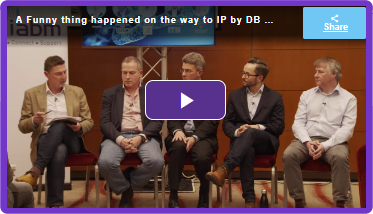Unlocking the secrets of a smooth transition to IP for media operations
Listen to this article:
While the media industry is accelerating toward IP technology, many companies still don’t see the bigger picture. This transition to IP is not just a regular technology upgrade, it's a true transformation! In this blog post, we’ll uncover the pitfalls of the traditional “one-off change” approach to transitioning to IP and unlock the secrets to a successful transition through Digital Transformation.
What’s Digital Transformation and how can you boost yours?
You will find the answer in our previous blog post “One simple thing that can boost your Digital Transformation”.
The transition to IP in the media industry is a typical example of a transition in a well-established industry, going from a purpose-designed technology (ASI/SDI), which is largely hardware-defined, to a general-purpose transformational technology (TCP/IP), which is largely software-defined. Let’s consider two scenarios.
Scenario 1: one-off change
The first scenario deals with the transition the way it has always been done: as a one-off change. As always, the solution will be designed and engineered by a team, with the goal to transport media flows across the new technology stack and support the known workflows. Once that goal is achieved, the new platform will be handed over to the operation team, who will run it for the coming years.
All the attention, budgets, and available energy are dedicated to the core infrastructure, which includes the switch fabric, media edge devices such as IP gateways and processing units, and a purpose-built IP signal routing solution or SDN controller.
All the attention, budgets, and available energy are dedicated to the core infrastructure.
During the implementation, all of the complexity, the architecture, and the configuration choices, such as the IPs and multicast addresses, will largely be managed in various documents and spreadsheets, which emerge from numerous conversations and meetings. After a lot of manual configuration and setup, the media services flows (ST2110-x, ST2022-6, etc.) across the new infrastructure and the workflows will finally be validated too. The goal is achieved—mission accomplished—and everything can be handed over to the operation team.
The harsh reality of the new world
But then, very shortly after reaching your goal, the harsh reality of the new world starts kicking in. Firstly, the need for change starts cropping up, and the frequency is much higher than anybody ever expected. Secondly, soon the realization comes that each change is much more time-consuming than any changes in the past. And last but not least, no matter how trivial a change may appear to be, there’s an inherent and very real risk of disrupting the ongoing operation.
Even if you already agree with this assessment so far, you are likely still underestimating the true extent of change in these new ecosystems. We will therefore dedicate one of our next blog posts to a more detailed discussion of this.
You are likely still underestimating the true extent of change in these new ecosystems.
However, in general, this is already quite apparent if you look at the actual real-life lessons learned from early adopters in the industry. All of those essentially boil down to a lack of readiness to deal with all sorts of changes.
Typical lessons learned from early adopters
“My biggest advice? Get a very comprehensive and permanent test and validation environment. I found that out the hard way 6 months into operation.”
“Our Excel sheet with all essential system configuration and setup reference data is so large it takes 20 minutes to open the file.”
“What used to be a straightforward 30-minute device swap-out job, which many people could perform, now sometimes takes my engineers days.”
“I cannot get rid of my system integrator; I need them continuously, also after the handover, and for all kinds of things that used to be trivial.”
“It feels as if I have become a system integrator myself.”
These statements are taken from the IABM live session "A funny thing happened on the way to IP", featuring panelists from dB Broadcast Ltd, ITN, Warner Bros, Discovery, and BBC Wales. You can rewatch the session on the IABM website but you need an IABM account to do so.
Scenario 2: Digital Transformation
The second scenario deals with the transition to IP as a Digital Transformation initiative. Consequently, it centers on the awareness that the actual end goal is not simply moving the SDI signals to IP, but also being ready to change and evolve continuously with that operation.
And now this suddenly becomes a completely new ball game: a change of perspective that could have a considerable impact on the choices of technology, the architecture of the overall ecosystem, the organization of the teams and people involved with the design, development, operation, and much more.
Ready for continuous evolution
Welcome to the world of Continuous Integration and Continuous Deployment (CI/CD), DevOps, Infrastructure as Code (IaC), and various other transformational concepts. This is a world that leverages agile development practices, automation at every stage of the software delivery process, and a collaborative culture that values rapid iteration and innovation.
Now there’s also the realization that the core infrastructure is not the most important and determining part of the overall solution. It is now much more about everything that wraps around that core infrastructure and drives it. Clearly, this also means that the initial efforts and investments will therefore be considerably higher. But then again, this will very quickly pay dividends in time saved when further change comes along.
It is now much more about everything that wraps around that core infrastructure and drives it.
In one of our next blog posts, we’ll also take a closer look at the details of all of this. But for now, know that a transition to IP is not simply yet another migration as you have seen many times in the past. It is Digital Transformation, and therefore it comes with many new paradigms.


